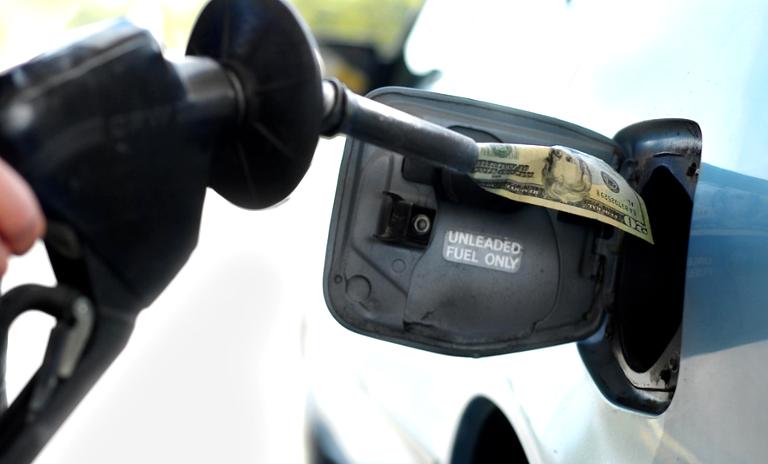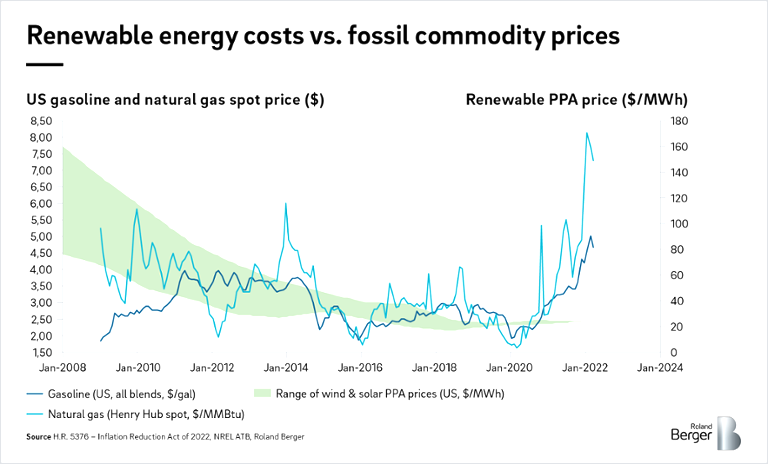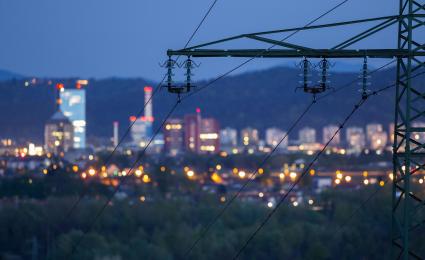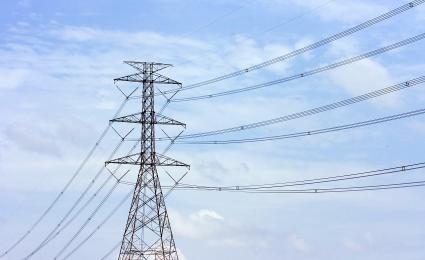Around the world, electric power providers are accelerating their efforts in mitigating climate change. Many have plans to decarbonize, and to substitute renewable power for fossil generation. But what does that mean for the power grid: the transmission and distribution network that brings electricity to consumers? How will decarbonization influence the topology of the grid, the technology that underlies it, and the management of the companies that provide it?


Will the Inflation Reduction Act Reduce - or Inflame - Inflation?
In the long run, decarbonization should result in lower and more stable energy prices… but be ready for a bumpy transition
Was the Inflation Reduction Act of 2022 (the "IRA") – a piece of legislation signed into law in August 2022 and chiefly focused on funding various measures to accelerate the decarbonization of the US economy – aptly named? Will the “IRA” succeed in reducing inflation – or inflame it?

Supporters and opponents of the bill have both tended to focus their arguments on its immediate potential impacts. Advocates underline the benefit of reducing US consumers' exposure to the high oil (and thus gasoline and diesel) prices sparked by the Russian invasion of Ukraine. Critics fret about the potential of billions of dollars of additional public spending to aggravate already raging inflation. Both of these arguments miss the real issue.
The transition to decarbonized energy sources may well result in long-term (post-2030) reductions in energy price levels and volatility, and thus some real reduction in overall inflation. The more urgent question though is the degree to which the transition itself will lead to increased energy costs and price volatility in the short to medium, and whether the resulting political repercussions will jeopardize the transition itself. The ease of the transition will depend on how quickly new supply chains can be established to support the re-creation of the US energy sector, practical solutions for coping with the increased intermittency of the post-carbon energy system, and how effective regulators and policy makers are in updating the rules needed to govern it.
We will thus provide our take on answering this question in two parts. First, over the long run, why should one believe the transition away from fossil fuel will reduce inflation? Second, in the near and medium term, what additional cost pressure may be created by the energy transition itself?
Why the energy transition will reduce expenditures on energy in the medium term
There are three inter-related reasons why the transition away from fossil fuel may reduce the level and volatility of expenditures on energy, and thus indeed reduce inflation. One is the normal consequence a more cost-competitive substitute product has on existing products. The second has to do with competitive dynamics of the fossil fuel sector; and the third, with the difference in cost structure between fossil fuels and decarbonized energy sources.
First, and most simply, the advent of decarbonized energy sources at parity with fossil-based fuels will place a new cap on fossil fuel prices. Over time, it will also lead to a decline in demand for conventional fuels and thus further reduce fossil fuel prices. All else being equal, this reduced level of price volatility could permeate through the economy, resulting in fewer episodes of energy-driven inflation.
The second reason relates to a distinctive characteristic of fossil fuels: the role of non-competitive pricing and limited pressure for productivity improvements to produce cost savings for consumers. As a matter of geological and geopolitical luck, the bulk of cheap-to-extract fossil fuel is under the control of a small group of sovereign oil producers, the Organization of Petroleum Exporting Countries (OPEC). They can often modify supply sufficiently to keep oil prices well above the level that would be expected if the market were more competitive, even with the advent of the “fracking revolution” in the US. For the past fifty years, OPEC members have often effectively set the global price of crude oil, and thus most other energy prices around the world.
From a longer-term economic perspective, their ability to realize fabulous profits with limited competition shields OPEC producers from the pressures to innovate to attract capital faced by more competitive industries. It is no coincidence that the energy sector has experienced fewer of the long-term productivity improvements and price declines realized by other capital-intensive industries. Even as sectors of the economy that use fossil fuel have made significant progress over the past 50 years in reducing the energy-intensity of the economy – the amount of energy required to produce $1 of GDP has decreased 64% since the 1973 oil embargo – the persistence of high prices for the raw product has made energy a perpetually significant contributor to inflation.
But couldn’t a post-fossil energy system also be subject to cartel-like control of critical inputs? Consider, for example, the need for mineral inputs for large-scale component manufacturing of lithium-ion batteries and PV panels where, mining and manufacturing are currently concentrated in China. If so, won't this negate the potential for declining energy costs over time, especially through productivity improvements?
We think not, for two reasons. First, most non-fossil energy technologies, including batteries, can use a range of potential natural resource inputs. These can be substituted for one another as relative input prices change, while staying within broadly comparable ranges of total cost. Second, the current concentration of mineral extraction and world-scale production facilities in China primarily reflects past national industrial policy, not unique resource endowments. This brings us to the third reason why the transition away from fossil fuel may reduce the level and volatility of expenditures on energy: the difference in cost structure between fossil fuels and decarbonized energy sources. The cost structure of fossil fuel reflects its distinctive energy density and convenience. This reduces the need for additional expenditure to convert fossil fuels into "useful" energy (e.g., light, motion, heat).
With non-fossil alternatives, a much higher share of the overall cost structure is manufacturing-based and fixed (e.g., the capital cost of a wind turbine). Consequently, the change in the total cost of decarbonized energy is much less sensitive to changes in resource input prices. Capital equipment expenditures occurs once over a project’s life and are amortized over decades, while fossil fuel needs to be paid on an ongoing basis. So even if cartels do emerge around the production of scarce minerals, their impact on total energy costs are likely to be less than what we've lived through with fossil fuels.
Finally, the greater reliance on manufacturing and materials science typical of decarbonized energy sources increases the scope for cost savings over the medium term through innovation, scale/network effects, and competition. These manufacturing and technology-heavy sectors have demonstrated their ability to enjoy the progress in total factor productivity realized in much of the rest of the modern industrial economy. They are also subject to the competitive pressures, and legal scrutiny for anti-competitive behavior, that OPEC has been able to dodge.
The figure below illustrates renewable energy costs' decline over time, compared to the oscillation of prices for natural gas, oil and diesel fuel.

The prospect of lower and less volatile energy prices will disproportionately benefit lower-income households. A 10% decline in energy prices (for home and transport) could raise total disposable income by 1-2%. It will also help reduce U.S. food costs, in which energy currently represents 20-30% of their total. Lower and less-volatile energy prices may also benefit a broad range of energy-intensive industries, from data centers to advanced manufacturing, along with the communities in which they are located.
Mind the Transition: How expensive will the energy transition be?
Unfortunately, neither the IRA nor any other piece of legislation can deliver the future of lower-cost, less volatile energy without a lot of additional work… and some luck. Transitions are messy and predictably unpredictable.That will almost certainly be the case with the energy transition, especially since it will be substantially accelerated with the passage of the IRA.
We envisage three sets of major challenges to realizing the potential of lower, more stable energy prices – and lower economy-wide inflation – from a post-fossil energy system. Each of these presents the possibility that the shift from fossil to decarbonized energy will be characterized by volatile prices and risks to reliable supply. They also pose the risk of a reversal of policy support for the transition, resulting in the sort of economically sub-optimal compromises that characterized the partial "deregulation" of the energy sector twenty years ago. Each of them also represent massive opportunities for market participants to profit from the discontinuities created by this historic transition.
Building the new energy system. Creating the supply chains to produce the necessary equipment will be daunting. It will take massive capital deployment and the coordination of numerous stakeholders. In the early stages, the rush to build the required manufacturing capacity, power generation and transmission capacity, and clean fuels capacity (including hydrogen and biofuels) will likely result in near-term supply chain constraints, supplier shortages, and price spikes.
Ironically, these challenges will be further exacerbated by efforts to develop domestic supply chains to support the construction of a post-carbon energy system. The effects of the Russian invasion of the Ukraine on energy prices, availability, and the broader economy has provided a painful illustration of the dangers of dependence on a small set of energy trading partners. Compounded by bipartisan skepticism concerning the benefits of globalization, this has led to including strong incentives for domestic sourcing of the material and manufacturing inputs of the energy transition, reflected in the content of the IRA.
The US currently lacks much of the requisite mineral production/processing and manufacturing facilities and skilled labor to produce batteries, or PV or offshore wind turbines. While creating a domestic supply base may well have longer term geopolitical and (domestic) political benefits, insisting on domestic source has a good chance of exacerbating upward pressure on the cost to build out the decarbonized energy system, and delaying its take off.
This could in itself lead to near-term increases in the capital equipment critical for the energy transition, temporarily reversing decades of impressive cost declines, and thus driving higher energy prices. Price increases resulting from supply chain kinks will be exacerbated by the hesitancy of investors to deploy capital for conventional energy infrastructure, such as gas-fired generation or life-extension investments in nuclear plants. These resources provide a necessary bridge between the current energy system and the future decarbonized system. As a consequence, challenges to system reliability and periods of severe price volatility may come to be seen as intrinsic features of a decarbonized energy system, rather than symptoms of a poorly orchestrated transition.
Coping with weather-dependent supply. Fossil fuel generation can be rapidly and efficiently ratcheted up and down to respond to often unpredictable (typically weather-induced) changes in demand, or sudden power plant outages. As these are replaced by wind and PV-generated power, electricity supply will become increasingly unpredictable, often reinforcing the weather-induced volatility of demand (think of breezeless and humid summer afternoons) . Moreover, the incremental contribution to system reliability provided by intermittent (renewable) resources will decline as they come to represent a higher share of total generation resources. This could result in inadequate power generation and more dramatic price volatility.
Over the coming decades, decarbonized solutions – such as price-responsive electricity demand, longer-duration energy storage, small modular nuclear reactors, and perhaps even more dramatic breakthroughs (e.g., fusion, space-based energy) – have the potential to address this challenge. Meanwhile, more effective use of the tools currently at our disposal will be critical to minimize the disruptions. This means building significantly more transmission capacity significantly faster than traditional permitting/interconnection processes have delivered over the past several decades..
Proposed reforms to the energy infrastructure permitting processes (e.g., the Energy Independence and Security Act of 2022) as well as more innovative transmission and distribution system topology for offshore (e.g., New York's "mesh ready" approach) and onshore systems (e.g., Southern California Edison's "Reimagining the Grid") may provide some relief to the chronic delays in developing new transmission. Leveraging new communication and control technologies to better leverage current demand management resources (like smart meters and thermostats) has the potential to deliver much greater flexibility to manage through near-term demand and supply shocks.
Redesigning markets for a post-carbon energy system. Clean electricity is the most essential ingredient to a decarbonized energy system. And the reliance hourly energy prices – based on the variable cost of electricity generation - to efficiently deploy resources is a key feature of traditional fossil-based electricity markets. Across most wholesale electricity markets in the US today, the electricity price generators are paid is set by the (next to) lowest bid to supply the electricity needed for a given time period. Each bidder's offer is determined by their respective variable cost of producing electricity (i.e., the cost of fuel and the much smaller variable operating and maintenance costs). In traditional fossil fuel-based power systems, this system provides a sufficient return for power generating companies to cover their fixed costs, and to a lesser degree, to fund investment in generation capacity as demand outstrips supply.
In most markets (Texas excluded), these generators are also paid extra to ensure reliable supply. The supply must be adequate to reach administratively determined levels of reliability for the system, in the form of "capacity prices." The mix of revenues received by generators varies depending on their operating cost and consequently how frequently they were dispatched to provide energy. Nonetheless, the dominant source of income for most generators is generally energy rather than capacity.
Going forward, this system will become progressively untenable. For a growing number of hours, the price will be set by a renewable generation unit with practically zero variable costs. Under the current system, this would result in energy prices and thus revenue of near zero for power generators. Moving forward, these companies will need to be compensated primarily for providing reliable supply and maintaining grid stability.
Ironically, incentives used to attract decarbonized generation can further distort the market. The subsidies used to incentivize the addition of renewable generation are likely to serve to depress returns for capital invested in the sector. If the market fails to attract sufficient, reliable generation - including demand side management and energy storage resources – the outcome could be economically and politically intolerable power outages and price spikes. The potential for wrenching financial losses for incumbent generators saddled with high variable cost capacity will become increasingly evident as the transition proceeds.
A major redesign of electricity markets will thus be critical for the energy transition to proceed smoothly. In the absence of the right market reforms, we could witness the wave of “stranded costs” that accompanied the liberalization of power markets in the US twenty years ago, or perhaps calls for nationalizing power producers as we are witnessing in Europe today.
Unintended Opportunities
The three challenges summarized above share several common features. Each presents the potential for near-term increases in energy prices and reduced reliability, with the potential to stimulate political opposition to energy transition reform. Each can be at least partially mitigated through targeted policy and regulatory interventions. And each presents intriguing opportunities for savvy investors and market participants to profit from new sources of scarcity (natural resources, manufacturing and logistics capacity, strategically located assets) and overcoming challenges posed by "missing markets" by proactively creating new supply networks and vertically integrating to produce inputs at scale needed for post-carbon energy technologies (e.g., Tesla's investments in lithium mining, refining, and battery production).
To respond to the question that opened this note – is the Inflation Reduction Act really going to reduce inflation – our response, is "yes, eventually" and "if" the combination of nimble market participants and wise policy makers can effectively navigate what will be a bumpy transition.
This article reflects the experience and insights of Roland Berger’s North American Energy and Industrials practices, based on extensive research and work with clients in the field. We will cover the implications in more detail in subsequent articles.
Sign up for our newsletter and get regular insights on newest publications related to Energy & Utilities.






